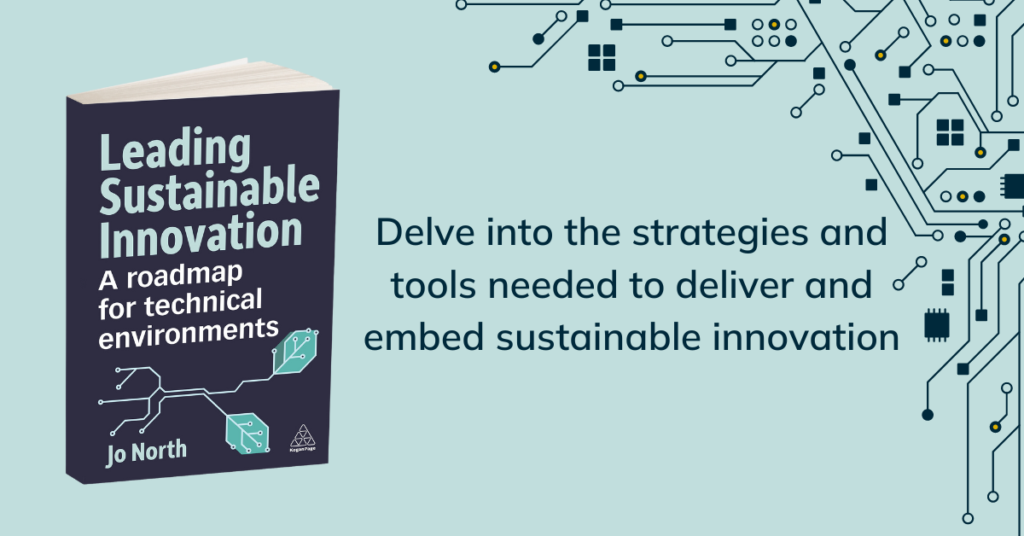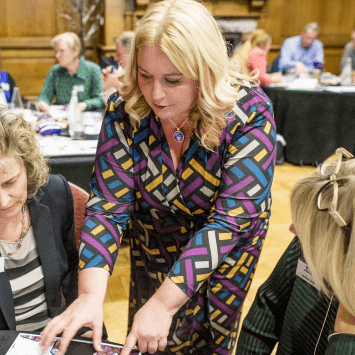Posted in Blog, Innovation, Sustainability by Jo North
You might think you’ve got sustainable innovation under control, but what if I told you that most leaders are missing key blind spots? These gaps could be costing you time, resources, and long-term growth opportunities.
In this article, I’ll expose the nine most common blind spots in sustainable innovation based on my experience of working with organizations around the world —and, more importantly, show you how to fix them.
These are key concepts I explore in my book Leading Sustainable Innovation, but here, I’ll provide you with a clear roadmap to start closing these gaps immediately. Let’s explore how to integrate sustainability into your innovation strategy, align it with stakeholder values, and adapt your project management approach for success.
1. Thinking Sustainability Has to Cost More
Many businesses wrongly assume that sustainability will always increase costs. This mindset prevents them from exploring more efficient, sustainable solutions.
In reality, sustainability often reduces long-term costs through energy efficiency, waste reduction, and streamlined processes. Many sustainable practices—such as switching to renewable energy or adopting circular economy principles—create operational savings over time. The misconception that sustainability always costs more is a significant blind spot that holds businesses back.
For example, on one of the innovation programmes that I run for entrepreneurs wanting to start or scale their business, a delegate, who happened to be a marketer, said that sustainability was simply a cost. She couldn’t see that it could also be a money-saver, and an investment when done effectively – just like marketing is. As a result, she risks losing out on some opportunities to improve her business and reach a segment of valuable clients who do care about sustainability.
Sustainability can sometimes cost more, to be truthful. I know of a business that is running a fleet of trucks on HVO (Hydrotreated Vegetable Oil), even though it’s significantly more expensive to buy than diesel. They are not passing all the costs on to their customers, but believe that it’s the right thing to do, and they can afford the price difference. Investing in sustainability, just like anything else, requires an affordable business case, as well as social and environmental cases – considering the triple bottom line in the round.
Actionable Steps
Look beyond the initial costs of sustainability initiatives. Analyze the whole life value, considering the financial and non-financial costs and benefits of your innovation, with an emphasis on the inclusion of sustainability factors, such as social and environmental impact, throughout the lifecycle. Include how sustainability can create savings in areas like energy, waste management and material sourcing.
Also consider third-party certifications, like B-Corp or LEED, that can offer financial incentives such as tax breaks or grant opportunities for sustainable practices. You may also be able to claim grant funding for some of your sustainable innovation initiatives.
Take a look a these entrepreneurial examples of sustainable innovation here for more inspiration.

2. Assuming Everyone Has the Same Understanding of Sustainability
Many leaders assume that everyone in their organization, customer base and across their supply chain shares the same understanding of sustainability. This can lead to misalignment in goals, priorities, and implementation efforts.
In reality, sustainability is interpreted differently depending on the stakeholder. For some, it might mean reducing carbon emissions, while for others, it could mean improving social equity or increasing resource efficiency. A lack of shared understanding is a major blind spot that can lead to inconsistencies in how sustainability initiatives are executed.
Actionable Steps
Create a shared sustainability vision and framework within your organization. Communicate it clearly to employees, customers and vendors. Define key terms and ensure that all stakeholders understand the specific goals and actions your business is pursuing. Also make sure that you understand theirs, so that you can collaborate more effectively to achieve your mutual objectives better and faster.
Run business sustainability workshops to ensure that everyone involved—from executives to suppliers—has the same understanding of sustainability, your company’s priorities, and their roles in driving sustainable innovation.

3. Not Integrating Sustainability into Your Innovation Strategy
Another blind spot is failing to integrate sustainability into your innovation strategy. Many leaders still treat sustainability and innovation as separate initiatives. However, true innovation today must have sustainability at its core.
If your innovations don’t consider their environmental and social impacts, you’re missing a key part of future-proofing your business. Today’s customers, employees, communities and investors expect sustainability to be embedded into every aspect of business.
Actionable Steps
Evaluate every innovation for its environmental and social impact. Make sustainability a central element of your business strategy, not an afterthought.
Because every innovation is an opportunity to either bring something new into the world, or to improve something that already exists, as a minimum we have a moral obligation to at worst do no harm, and preferably to make a positive difference where we can.
Use sustainability as a key performance indicator (KPI) in your innovation efforts. Evaluate success not only by financial returns but also by environmental and social benefits.
4. Fear of Failure and Not Adopting an Experimental Mindset
The fourth blind spot is the fear of failure. Sustainable innovation involves experimentation, and not every new approach will succeed on the first try. Many leaders fear failure, leading them to stick to what’s safe. This mindset stifles progress.
Businesses that embrace experimentation move faster and innovate more effectively. They treat failure as a necessary part of the process. Sustainable solutions often require multiple iterations to refine and succeed.
Actionable Steps
Encourage a growth mindset and culture of experimentation in your organization. Start with small pilots and use failures as learning opportunities to refine your approach.
Create a “failure portfolio” where teams document lessons from unsuccessful projects. This allows for collective learning and improvement.
5. Trying to Solve Everything Internally
Sustainable innovation challenges are often too complex for any one organization to solve alone. However, many leaders still attempt to tackle these problems internally, limiting progress.
Collaboration is critical for solving sustainability challenges. Businesses that partner with suppliers, industry peers, and even competitors are better positioned to innovate. External collaboration reduces risk, shares resources, and allows for quicker adoption of solutions.
Actionable Steps
Identify key external collaborators—whether it’s customers, suppliers, industry coalitions, or even competitors. Create partnerships that can accelerate your sustainability efforts.
Join industry consortia focused on sustainability. For example, organizations like The Ellen MacArthur Foundation help companies collaborate on circular economy initiatives, providing access to shared knowledge and solutions
Intentionally cultivate a healthy, collaborative innovation ecosystem for your organization.
6. Putting Off Tackling Scope 3 Emissions
A lack of understanding of the different types of emissions and the failure to address Scope 3 emissions, which are often the largest, is a major sustainable innovation blind spot.
- Scope 1: Direct emissions from owned or controlled sources, like company vehicles or facilities.
- Scope 2: Indirect emissions from the generation of purchased energy, such as electricity.
- Scope 3: All other indirect emissions in a company’s value chain, including raw materials, product use, transportation, and waste disposal.
Many businesses focus on Scope 1 and 2 emissions, which are easier to control, but parking Scope 3 emissions in the “too difficult” pile can result in missing the most significant part of your environmental footprint.
Actionable Steps
Map out your Scope 1, 2, and 3 emissions. Work with suppliers to reduce Scope 3 emissions and engage your customers to minimize their environmental impact when using your products.
Use an emissions hierarchy to prioritize reduction efforts, starting with Scope 3 areas that account for the largest share of your total emissions, such as logistics or materials, as well as as with smaller, quick wins

7. Using Old-School Project Management for Sustainable Innovation
Many leaders still rely on traditional project management approaches for sustainable innovation, relying on rigid timelines and fixed budgets. However, sustainable innovation is often more complex and requires flexibility.
Wagile project management, which combines the structured planning of waterfall with the flexibility of agile, is better suited for managing sustainable innovation projects. It allows for iterative development while maintaining overall project structure.
Actionable Steps
Adopt wagile project management in your sustainability initiatives. This combines structured planning with flexibility to make adjustments as new information becomes available or priorities shift.
Create a “learning loop” within your wagile project management approach with retrospectives, where teams pause after each phase to review outcomes, refine strategies, and incorporate feedback.
8. Not Appreciating the Transition Phase of Sustainable Solutions
We are in a transition phase with many sustainable technologies, such as renewable energy, carbon capture, and circular materials. Some leaders wait for these solutions to fully mature before adopting them, but this can lead to missed opportunities.
Leading companies adopt sustainable technologies early and pilot these solutions to experiment and learn. Early adoption positions businesses as innovators and allows them to stay ahead of competitors.
Actionable Steps
Be willing to experiment with emerging sustainable technologies. Pilot new solutions and adapt them as they evolve to gain an early advantage.
Consider using a hybrid model where you gradually integrate new technologies while still leveraging existing systems. This reduces the risk of failure during the transition phase.
9. Ignoring Stakeholder Value and Priorities
As well as technology, sustainable innovation is about creating value for the people who matter most to your business. Many leaders fail to align their innovation efforts with stakeholder priorities, which can limit the success of their projects.
For example, Crossrail, a major infrastructure project in the UK, made sustainability a core priority, aligning its innovations with the expectations of the public, government, and environmental groups. By embedding sustainability into its design and operations, Crossrail minimized environmental impacts, reduced emissions, and improved stakeholder engagement.
Actionable Steps
Conduct a stakeholder value assessment. Identify what matters most to your customers, employees, communities and investors, and align your innovations with their priorities.
Engage stakeholders early in the innovation process. Co-creation workshops with customers, suppliers, and employees can help identify their sustainability priorities and ensure that innovations reflect their needs.

10. Thinking Sustainability Efforts Have to Be Perfect
One of the biggest misconceptions about sustainability is the belief that your efforts have to be perfect. Many leaders feel paralyzed by the pressure to implement flawless sustainability initiatives, thinking that unless they can do everything perfectly, it’s not worth doing at all. This mindset can lead to inaction or endless delays.
In reality, sustainability is a journey, not a destination. It’s about doing what you can and continuously improving over time. Even small steps toward sustainability can have a significant impact. Striving to be the best you can be within your current capacity is more important than waiting until you can implement an ideal solution.
Actionable Steps
Start with what you can manage today. Take small, achievable steps toward sustainability and build from there. Set realistic goals and make continuous improvements as you learn and grow.
Use a phased approach to sustainability. Prioritize easy wins first—such as energy efficiency or waste reduction—and gradually tackle more complex issues like supply chain sustainability. Start to chip away at challenging items now, breaking big projects and programs into more manageable chunks. This builds momentum and makes it easier to expand your efforts over time.
Being 1% better every day, consistently, leads to a x37 improvement over a year. Small improvements compound over time.
Practical Actions to Fix These Sustainable Innovation Blind Spots
Addressing these ten blind spots will put your business on a stronger path to sustainable innovation. Here’s how to fix them:
- Analyze long-term sustainability costs. Look beyond upfront costs and consider the full lifecycle value.
- Create a shared understanding of sustainability. Align your team and partners on what sustainability means for your business.
- Make sustainability central to your innovation strategy. Ensure that every innovation you develop has sustainability at its core.
- Adopt an experimental mindset. Start small, pilot new approaches, and learn from failures.
- Collaborate with external partners. Leverage partnerships with suppliers and industry groups to accelerate sustainable solutions.
- Map Scope 1, 2, and 3 emissions. Don’t put Scope 3 into the ‘too difficult’ pile. Start now. Engage your supply chain and customers to reduce indirect emissions.
- Use wagile project management. Combine structured planning with flexibility to handle sustainability challenges.
- Experiment with sustainable technologies early. Pilot emerging technologies and adapt as they evolve.
- Align your innovations with stakeholder values. Make sure that your innovations reflect what’s important to your customers, employees, and investors.
- Remember that perfection is the enemy of progress. Focus on doing the best you can and on continuous improvement.
Sustainable Innovation Blind Spots: Further Reflections
Sustainable Innovation is Not a Niche Concern
In recent years, business leaders have shifted their approach to sustainability and innovation. The good news is that large companies and social entrepreneurs now see the value of a holistic approach to environmental sustainability. However, a key sustainable innovation blind spot remains: the belief that sustainability is a niche concern or only relevant to certain sectors. This misunderstanding leads to missed opportunities for businesses across various industries, especially large companies and their supply chains.
Social Capital Plus Profitability
For long-term success, business owners and senior leaders must take a proactive approach. They need to view decisions through the lens of sustainability. An environmental scan can help them spot business risks and investment opportunities. What Ross Baird, President of Village Capital, calls one-pocket thinking, where profit and sustainability are separate, doesn’t work anymore. Instead, two-pocket thinkers—those who link social capital and profitability—are more likely to succeed.
Sustainable Innovation Culture Wins
Innovation across sectors, from sustainable materials to new technology, requires early action. Forward-thinking companies already see the patterns: those who integrate sustainability into their culture are seeing positive results. Capital markets and investors are increasingly favoring companies with a strong track record of social impact and a clear understanding of business risks. These companies are leading the shift toward a sustainable innovation economy.
Resisting Change is Risky Business
The bad news is that many businesses remain stuck in their comfort settings. They resist change. Yet, making fundamental shifts toward sustainable business solutions is the right thing to do. It might take hard work, but leaders who act now, scanning their environment and investing in sustainable development, will be ready for the future. They’ll create new products and business solutions that lead to long-term success. Those who move fast in the near future will find themselves in a better position, with a business built on resilience, sustainable innovation, and positive social change.
Business Case for Sustainable Innovation
Climate change has been a driver for new ideas in business and beyond. Yet, many big companies still hold onto wrong ideas about their role in solving this global challenge. Businesses across various sectors have seen how the current economic system creates both opportunities and barriers to innovation. These major blind spots slow progress. For a long time, business owners believed that sustainable practices would negatively impact profitability. However, case studies now show that companies that embrace technological development and embed sustainability into their organizational culture are seeing positive outcomes and paving the way for future success.
Sustainable Innovation Needs to be in Your DNA
Global warming affects the entire global population, and businesses that acknowledge this sustainable need are better prepared for the big challenges ahead. Companies that introduce new products with sustainability in mind—rather than as an afterthought—are the early birds, reaping the rewards. It’s about great ideas and addressing the mindset gap that prevents some leaders from acting. Entrepreneurial activity plays an important role here, showing that business success comes from both innovation, responsibility and an appetite for calculated risk. By embedding sustainability as a core function, organizations can create a positive impact while preparing for long-term, sustainable growth.
For those businesses that understand the need for fundamental change, the path to positive outcomes becomes clearer. The key is recognizing that sustainability is not a side initiative but an essential part of your overall strategy. Whether you’re a large corporation or a small business owner, the right ideas can transform how you operate, setting your company up for future success and putting you in a better place to thrive in the face of the global challenges ahead.
Next Steps
By addressing these ten blind spots, you’ll lead more effective and forward-thinking sustainable innovation. You’ll be better positioned to meet stakeholder expectations, stay ahead of and within regulations, and future-proof your business. These are the kinds of frameworks I explore in greater depth in my book Leading Sustainable Innovation, providing detailed strategies for embedding sustainability into your core business practices.

Take action now to close these gaps, and your business will be more resilient, competitive, and ready to thrive in a rapidly changing world.
After reading this article, I hope you’ve identified critical blind spots in your sustainable innovation strategy and gained actionable steps to address them. I also hope you have a deeper understanding of how to integrate sustainability into your innovation processes, improve collaboration and communication, and adopt flexible project management approaches, helping your business stay competitive and resilient in the evolving sustainability landscape.
I’d love to hear from you. Please do get in touch here, and let me know of your sustainable innovation successes and challenges.


